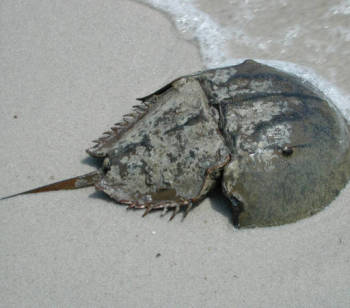Horseshoe Crab
Category: Crab

Facts about Horseshoe Crabs, "Scientific name for Horseshoe Crab is Limulidae" Horseshoe Crab and it is a sea arthropod that belongs order Xiphosurida or Xiphosura. The Horseshoe Crabs live chiefly in and around low sea waters on soft muddy or sandy bottoms. Occasionally, they come onto the seashore to mate. They are generally used in fertilizer and as bait. The Horseshoe Crab has been considered a living fossil due to its origin 450 million years ago.
Features
The whole body of the Horseshoe Crab is secluded by a firm carapace. Usually, adult female Horseshoe Crabs are bigger than the males, with the body size of 24 inches (60 cm). The young Horseshoe Crabs grow 33% bigger with each molt pending they attain the size of an adult crab. The Horseshoe Crab has two composite lateral eyes, and each is made up of 1000 ommatidia. The Horseshoe Crabs also have a pair of median eyes, which are capable of detecting both ultraviolet light and visible light. They also have a pair of rudimentary lateral eyes and a single endoparietal eye on the top. The rudimentary lateral eyes become useful just earlier than the embryo emerges. Furthermore, the Horseshoe Crab has a pair of ventral eyes that is situated close to its mouth, in addition to a group of photoreceptors on its telson.
In spite of having a somewhat poor vision, the Horseshoe crab has the biggest rods and cones of any recognized crab, about 100 times the human size. The mouth of the Horseshoe Crab is situated in the middle of its legs, where their bottoms have the similar function as its jaws and assist to grind up the food. The Horseshoe Crab variety has five pairs of legs, intended for swimming, walking, and moving food into its mouth, each is equipped with a claw at the tip, excluding the end pair. The elongated, straight, inflexible tail of the Horseshoe Crab can be exercised to turn itself over if twisted upside down, so a crab of this variety with a wrecked tail is more vulnerable to predation or desiccation.
The Horseshoe crab has book gills behind its legs, which swap respiratory gases and are rarely employed for swimming, as well. The Horseshoe Crabs have no endoskeleton, but their body has an endoskeletal arrangement, composed of cartilaginous plates, which support their book gills. Normally, the Horseshoe Crab variety swims upside down, inclined at an angle of 30% to the horizontal and it is capable of moving at a speed between 10 cm/s and 15 cm/s (0.22 mph and 0.34 mph). In spite of this, the Horseshoe Crabs are usually found on the sea ground, probing the food.
Diet
The Horseshoe crab mostly feeds on Molluscs and worms that are usually found on the sea ground. They also feed on small fish and crustaceans.
Breeding
During the breeding period, Horseshoe crab varieties travel to low coastal waters. A male chooses a female and sticks to her back. The female Horseshoe Crab excavates a hole in the sand and it will lay her eggs, whereas the male Horseshoe Crab fertilizes them. The female Horseshoe Crab is capable of laying eggs, ranging from 60,000 to 120,000 in batches of some thousands at a time. The eggs take 14 days to hatch, and the larvae molt six times in the first year.
The maximum lifespan of the Horseshoe crab is 20 years.

 Back To Category Crab
Back To Category Crab